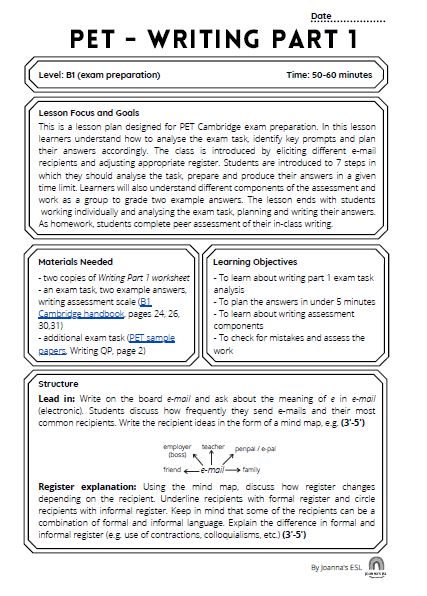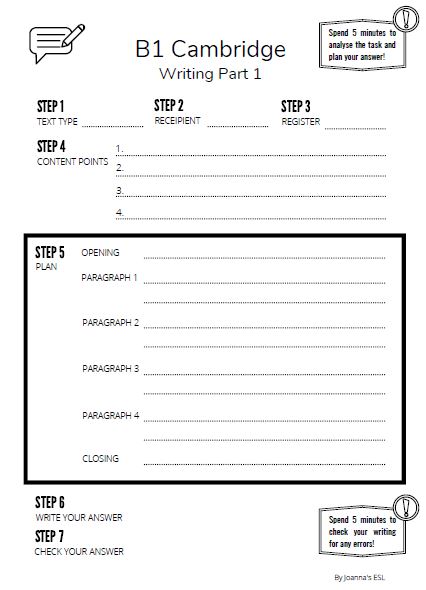Teaching writing can be quite hard – especially teaching writing for exam preparation.
Like every teacher, I have my most and least favourite things to teach. It is quite easy to focus on the parts that we really enjoy and neglect the parts that we don’t fully understand or we just don’t have that much fun with. I’ve got some groups that I can play around with, we can watch some videos, listen to music… There are also some groups that are strictly preparing for the Cambridge exams.
While preparing for Cambridge exams I always try to make sure that my students understand each part of it, but most importantly, they know how to produce answers. As in every exam, there is a certain key that learners need to follow and if they know how to achieve that, they can score really high!
There are so many resources distributed by Cambridge Assessment English. As I am not reinventing the wheel, I decided to use one of their materials and adapt them to my class. In order to follow my lesson plan, it is necessary to download B1 Preliminary Handbook and Sample Papers for B1 Preliminary. You can download them by clicking the links or by going to the official website. All the pages used in this class are specified in the lesson plan.
This lesson consists of two files, a lesson plan and a worksheet that is designed to help learners understand how to approach writing part 1 exam task and how to answer it by following the Cambridge writing assessment scale. There is an additional worksheet with suggested answers to make sure that learners understand each step of the exam task. You can download all three files by clicking the links at the end of the post.


In order to score high, it is important to get your learners used to following the steps of the exam task analysis and planning before writing.
Step 1 – text type
As a group look at the exam task and identify the type of text. This part of the exam is mandatory and students are always asked to write an e-mail. It may seem like an unnecessary step, but I can’t remember the number of times that my students forgot over and over again what they were expected to write.
Step 2 – recipient
One part of the assessment is correctly identifying and approaching the target reader. In this part, students should be aware that most likely they will have to write an e-mail to a friend or a teacher, which obviously will affect their vocabulary.
Step 3 – register
Once learners name the recipient, they should be able to identify the register of their response. In the case of writing to a friend, they can use contractions and less formal language. If the message is intended for a teacher, they should change the register appropriately.
Step 4 – content points
Allow your students to read the message again and identify four main content points. Once students know what they need to address, they should be able to respond correctly, for example, if the message tells them to suggest an activity, learners should use appropriate language and vocabulary relevant to the task. Emphasise that the answers shouldn’t be longer than 100 words, therefore they need to focus on answering the content points without getting too distracted.
Step 5 – plan
Based on the content points learners should be able to plan their answers. If you do it for the first time ever, you can do it as a group to show that students should only write basic ideas and some useful vocabulary. It is quite difficult to convince learners to plan their answers, but remind them that according to the writing assessment scale, they can score up to 5 points for well-organised, linked and coherent answers. Remember that the planning stage shouldn’t be longer than 5 minutes.
Step 6 – write your answer
Now following the plan, students should write their answers in about 10 minutes. It is good to get your learners to work under a time limit to avoid any bad surprises in the exam.
Step 7 – check your answer
Yes, you made it! The answers are written and the exam is about to end. However, tell your learners that if they find themselves with some spare time on their hands, they should read their answers AGAIN and see if they still make sense. It is also a good idea to drill some most common errors, so your pupils know exactly what they are looking for. This shouldn’t take more than 5 minutes.
In order for your learners to really know what they need to do, it is good to spend some time explaining the writing assessment scale. Go through each of the points and back them up with some examples for better comprehension and give everyone a copy of the scale. To make it even more effective try following each writing with peer assessment because there is no better way to learn than from each other!
Hope you enjoy this lesson plan! You can download the lesson plan, writing worksheet and suggested answers below! Be on the lookout as there is more exam content to come.

4 thoughts on “Cambridge PET – Writing Part 1”